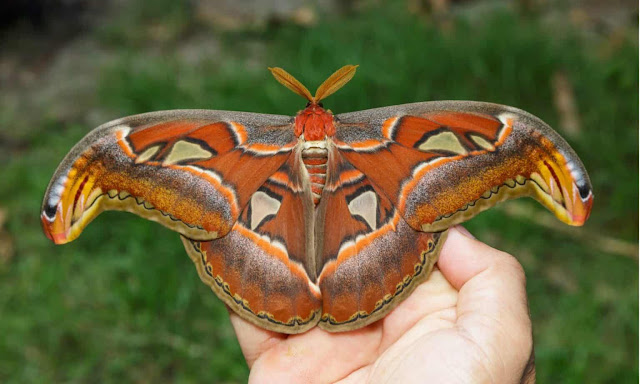Atlas moth article – big, beautiful, strange life; learn about its size, mimicry, diet (or lack of), and dramatic lifespan. Easy to read, Veritas Times.
 |
| Adult atlas moths do not eat; they live off the fat they stored as larvae. |
The Astonishing Atlas Moth
Asia has a gentle giant in its forests, the Atlas moth, famous not just for its size but also for the extraordinary snake-like patterns on its wings. From India to the Philippines, this massive creature stretches its wingspan to nearly 24 cm—wider than your palm!
A Wingspan That Stuns
With wings colored in rusty browns, yellows, reds, and purples, the Atlas moth ranks among the top three largest moths globally. Its wing surface area can reach an impressive 160 cm², making it second only to the Hercules moth in sheer size.
 |
| Adult atlas moths do not eat - they live off the fat they stored as larvae. |
Nature’s Living Camouflage
Ever wondered why the wing tips look like snake heads? It’s no accident. This uncanny mimicry deters predators, cleverly fooling them into thinking a venomous cobra is lurking nearby. Combined with false eyespots, the Atlas moth is a master at survival.
Hungry Caterpillars, Starving Adults
The moth starts life as a ravenous caterpillar, feeding on leaves of citrus, cinnamon, guava, and more. In just a few weeks, it grows nearly 11.5 cm long—a true eating machine.
But adult Atlas moths are born without functional mouths. Having no ability to eat, they survive only on fat stored during their caterpillar days.
 |
| Adult atlas moths do not eat - they live off the fat they stored as larvae. |
The Unforgiving Race to Mate
Once transformed, adult moths spend their short lives—just one to two weeks—focused solely on mating. Females release pheromones and lay up to 150 eggs before dying of energy exhaustion.
A Silk Story and Conservation Concern
Though not as famous as silkworms, Atlas moth cocoons are used to produce a special silk called “fagara,” valued for its toughness and durability. Some are even crafted into purses or scarves. In parts of India, they are farmed for this purpose.
Sadly, habitat destruction threatens their future. These forest dwellers depend on tropical ecosystems—a reminder of why protecting their homes matters.
You may like: Gerenuk: The Giraffe-Gazelle of Africa You Never Knew About
Ramkinkar Baij: The Forgotten Genius of Indian Art
